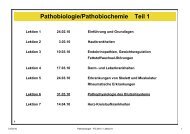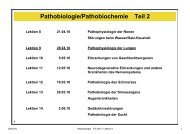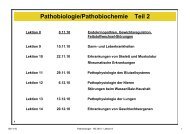Pathobiologie/Pathobiochemie Teil 2 - Alex Eberle
Pathobiologie/Pathobiochemie Teil 2 - Alex Eberle
Pathobiologie/Pathobiochemie Teil 2 - Alex Eberle
Erfolgreiche ePaper selbst erstellen
Machen Sie aus Ihren PDF Publikationen ein blätterbares Flipbook mit unserer einzigartigen Google optimierten e-Paper Software.
Schalltransduktion im Innenohr<br />
An Outer Hair Cell Crowned with an Array<br />
of Stereocilia Connected by Tip Links<br />
The vibrations of the basilar membrane caused by<br />
the oscillations of the perilymph induce shearing of<br />
the tectorial membrane. This leads to bending of the<br />
stereocilia, which stretches the filaments that link<br />
neighboring stereocilia, thereby opening unidentified<br />
potassium channels in the membrane of the<br />
stereocilia through the action of myosin. Myosin 7A<br />
and myosin 15 are probably involved in the<br />
movement of these stereocilia. The protein<br />
diaphanous is also expressed in hair cells, in which it<br />
recruits actin-binding proteins to the cell membrane,<br />
thereby regulating actin dynamics. The myosindiaphanous-actin<br />
cytoskeleton is responsible for the<br />
structural integrity and dynamics of the hair cells.<br />
Otoferlin may be involved in the transport of synaptic<br />
vesicles to the plasma membrane. The potassium<br />
channels formed by the KCNQ4 protein (yellow) and<br />
by the connexins (red) allow recirculation of the<br />
potassium ions from the hair cells to the stria<br />
vascularis and the endolymph. Connexin channels<br />
are shown in red.<br />
16<br />
Willems, New Engl J Med, 2000<br />
26/05/10 <strong>Pathobiologie</strong> - FS 2010 - Lektion 13 16





